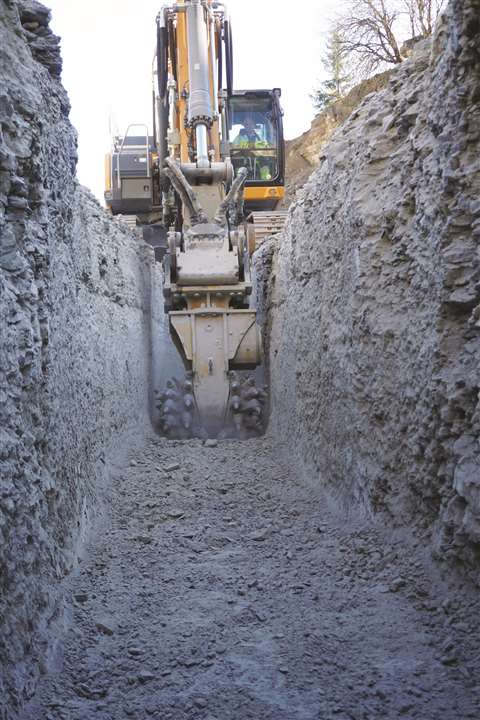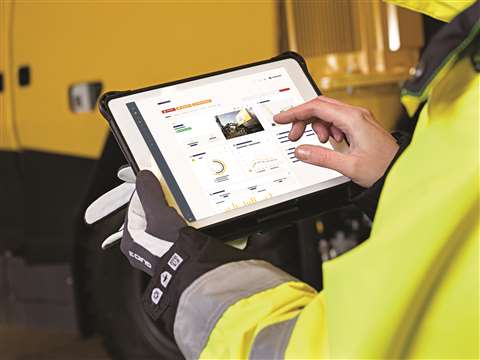Exclusive interview: Epiroc CEO on technology in construction
11 October 2022
Helena Hedblom, CEO of Epiroc, tells Andy Brown why now is an exciting time to be in the increasingly high-tech construction and mining sector.
 Hedblom says that overall market conditions remain positive. (Photo: Epiroc)
Hedblom says that overall market conditions remain positive. (Photo: Epiroc)
Towards the end of our interview Helena Hedblom, CEO of Swedish-based Epiroc, lets out a laugh.
Throughout the video call Hedblom comes across as thoughtful, impressive and laser-focused on business – the laugh occurs when she is considering the size of the mindset change required for companies, and the industry as a whole, to properly benefit from new technology.
“Technology has really helped us to have seamless interaction with our customers and fact-based information, so that we can be proactive instead of reactive.
“And, of course, that enables higher up-time and better utilisation, higher productivity. This is a journey that is ongoing, both in construction and mining at the same time,” she comments.
Hedblom then points out that the technology also requires, “a change in management process as well. The technology is one thing, but it is really about changing the way you’re working and to really trust the technology.”
Business has been good for Epiroc, which produces mining and construction related equipment, with sales for 2021 of approximately US$4 billion – sales have remained strong in 2022 so far.
The high number of infrastructure projects around the world has been a benefit to all of construction and levels of demand have been high.
Construction technology trends
“If we look at the underlying drivers for construction, they remain strong, and the same goes for mining,” she says. “From a construction standpoint, many countries in Europe have been very strong regarding activity levels, as has the US and China.
“We see strong activities related to urbanisation and traffic infrastructure. And, of course, the push to more legal standards related to both environmental protection and safety.
“That means there’s more and more demand for higher technology levels of the machines and the equipment; that’s our strength. I think we are well positioned for the future needs of customers and also related to the new legislations and the trends when it comes to ESG.”
This demand for higher technology benefits those that have been working on them for years or even decades.
Hedblom says that Epiroc has been focused on new technology, such as electrification, for a long time so their mindset shift occurred some time ago.
 Helena Hedblom, CEO of Epiroc. (Photo: Epiroc)
Helena Hedblom, CEO of Epiroc. (Photo: Epiroc)
“We started this journey many years ago – we actually started to try battery technology before the cell technology really had the cell density that could cope with the weight of our machines,” she says.
“We learned a lot during those years, and where the cell density is right now, our machines can be turned into electric drive lines, and that’s what we are busy doing.”
New technology – and alternative power – goes hand in hand with the other major trend in the industry: sustainability.
When it comes to alternative power some OEMs are adopting ‘power neutral’ stances, but Hedblom is clear that, for Epiroc, electric is the answer.
What are Epiroc’s sustainability targets?
Epiroc has lofty sustainability targets – the company has ambitions to halve CO2 emissions from its own operations and transports, as well as from products sold, by 2030.
A key way to achieve this, according to the CEO, is through electric power. “When we look at our total [emissions] and where we can make a difference, it is really to change from diesel engines, to battery electric drivelines,” she comments.
“That’s really where we can make the biggest impact, both in the construction and mining space. We have been working with electrification for many years now and we are very well positioned. We are committed to driving that forward.”
There are two main ways that the company is doing this – through R&D and acquisitions. Hedblom says that the company has been investing more than ever in R&D over the last few years and a big – and increasing – portion of that goes into electrification.
Construction equipment and electric power
Regarding company acquisitions, Epiroc has purchased a number of companies and the strategy seems well thought out: they are buying businesses for the different stages of the electrification process.
One of these is a company that has the capability to retrofit existing diesel machines so they run on battery technology instead.
Recognising that infrastructure is one of the biggest barriers to electric power they have also acquired two electrical infrastructure companies. By 2030 Epiroc says that it will offer its full range of all equipment with zero emission solutions.
Alternative power is an important aspect of new technology, but it is only one aspect. Hedblom says that, with all the new technology available, “We have an exciting couple of years ahead of us where a lot will change.”
When she talks about this exciting time ahead, she is referring, in no small measure, to automation.
“Automating machines comes with the possibility to be more precise, more predictable in what you’re doing. We see the type of solutions that we are developing and that we’re launching, it’s all about making sure that the machines perform the work in a more precise way,” she comments.
“This is a journey that is ongoing, both in construction and mining. Even though, in mining on the automation side, we are more into fully automated fleets and mixed fleets. We don’t see that in the construction site yet.
 Technology is increasingly common in the construction industry. (Photo: Epiroc)
Technology is increasingly common in the construction industry. (Photo: Epiroc)
“Every time you can allow the machine to do different steps without interaction or an operator you have the possibility to increase efficiency and productivity as well as safety.”
How can construction attract workers?
The benefits of using and integrating new technology could be more wide-ranging than increased productivity and efficiency; it could help entice a new generation of workers.
“It requires different competencies to manage these types of technologies and make sure that they will work on the construction site.
“This is a great opportunity for us to attract the younger generation to the mining and construction industry, because they are seen as old-fashioned industries, but they are really becoming high tech industries. It’s a great opportunity to attract the young generation.”





